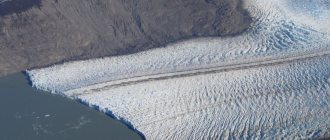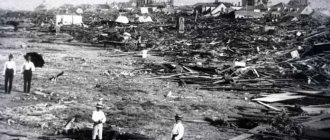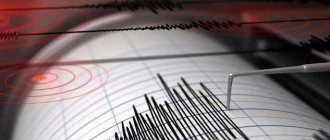The concept of “tsunami”: signs, classification
A word of Japanese origin meaning “wave in a bay, bay . A tsunami is a series of high waves that form in the ocean water or other body of water.
An interesting feature of a tsunami is that the height and speed of the wave varies depending on the thickness of the water. The wave that arose in the center of the ocean has a high speed of 600-900 km/h and a wave height of up to 0.5 meters . It does not pose a danger to ships. But as it approaches land, its speed decreases to 100-300 km/h , and the height increases to 30-70 meters near steep shores. This is the danger of a tsunami to human life. The time interval between waves can range from several minutes to 1 hour. Therefore, you should not return to the shore immediately after the first wave. We need to wait in a safe place for several hours.
Causes of tsunamis
Up to 7% of all tsunamis are caused by landslides, when huge blocks of earth, rock or ice fall into the water. In 1958, in Alaska, such a landslide led to the formation of a wave 524 meters high.
Underwater landslides in river deltas are also dangerous. Landslide tsunamis regularly occur in Indonesia and result in twenty-meter tsunamis. Another 5% of cases occur due to underwater volcanic eruptions. Human activity can also lead to a tsunami, for example, testing of deep weapons.
Up to 85% of all cases where tsunamis have been recorded are associated with underwater earthquakes. At the same time, the ocean bottom shifts vertically, and the surface of the water begins to move, trying to return to its previous level. Tsunamis are mainly generated by earthquakes with sources located close to the surface.
During earthquakes, surface waves called local tsunamis emanate from the site of vertical shear. The height of such waves can reach thirty meters. At the same time, underwater waves diverge from the epicenter, passing through the entire thickness of the water, from the bottom to the surface, and moving at a speed of 600 to 800 kilometers per hour.
As the depth of the ocean decreases, the energy of such a wave is concentrated closer to the surface, resulting in such distant tsunamis hitting the shore. A remote tsunami can cross from end to end of the Pacific Ocean in a day, reaching from the coast of Chile to the islands of Japan.
Moreover, it is almost impossible to notice such a wave in the ocean - with a length of 200-300 kilometers, it has a height of up to a meter. This is the main insidiousness of the tsunami.
Signs of a tsunami
- An unexpectedly rapid and complete retreat of water from the coast to a great distance deep into the sea, bay, or ocean. The further the water goes into the sea, the higher and more merciless the wave will be.
- Powerful earthquake in the sea, ocean ( above 7 points ). If it is practically not noticeable on the coast, this does not mean that the tsunami will not reach the coast. It is better to leave in advance to a safe distance.
- In cold conditions, huge, sedentary blocks of ice crack, float over each other and onto the shore, cracks and currents form.
- The approaching huge wave makes a rumbling sound.
- Animals are the first to react to natural disasters of this kind and try to leave the site of a possible tragedy in advance.
Tsunamis are classified according to the number of human casualties and intensity.
According to the number of victims there are:
- No human deaths.
- Resulting in the death of up to 50 people.
- With deaths ranging from 51 to 100 people.
- With deaths ranging from 101 to 1000 people.
- More than 1000 deaths.
They are divided according to intensity:
- Very weak – 1 point.
- Weak – 2 points.
- Average – 3 points.
- Strong – 4 points.
- Very strong – 5 points.
- Catastrophic – 6 points.
Signs that indicate an approaching tsunami
Scientists have learned to identify signs of a possible tsunami based on seismic activity on the ocean floor.
Monitoring is carried out in a continuous mode. Warning systems have been established in countries where the occurrence of this terrible event is considered most likely, i.e. in states with a coastal ocean (or sea) zone.
But even an ordinary person can determine that a wave will soon hit land if:
- on the coast, the seabed was exposed at a considerable distance from the shore. The sea seems to “go away”, sometimes to a distance of several kilometers. And the further the water recedes, the higher the tsunami wave will be;
- An earthquake occurred and its epicenter was in the sea (ocean).
The population of countries where tsunamis are possible are usually informed about the actions they should take when a wave is declared approaching.
The most reliable means of rescue is to climb to natural heights, the height of which exceeds 40 meters, and they are located 3 - 4 km from the coastal zone, when a warning is announced.
If the warning is late, then you need to go up to the highest floors of the building and hide away from windows and stairwells.
If the elements catch you on the street, then you need to grab onto a strong structure or tree so that the outgoing wave does not carry you out to the open sea. But, of course, this can only save with a low and not very powerful tsunami wave.
Causes of tsunami
The causes of tsunamis are most often natural, but there are also man-made and artificial, i.e. caused by human activity.
- Underwater earthquakes . According to statistics, 85% of tsunamis occur due to underwater earthquakes. In the contact zones of the lithospheric plates of the earth's crust, they collide and shift relative to each other. This leads to a change in the topography of the seabed: one part of it rises, and the other goes down. The earthquake resonates with the vibrations of the sea wave, causing the sea water to rise to a considerable height. Not all underwater earthquakes lead to tsunamis, but only those that have an epicenter located close to the surface of the seabed. By determining the power of an earthquake, scientists can predict with a high degree of probability the possibility of a tsunami. But forecasts can be wrong.
- Landslides . Earthquakes on land and water can trigger large landslides. At the same time, huge blocks of coastal and underground rocks and glaciers collapse. They fly at high speed from a height of about 1 km. This is especially dangerous in bays, bays, and rivers, when collapsed rocks create a wave. It reaches the opposite shore, destroying human buildings, taking lives. There are places in the world that are prone to this kind of regular tsunami: Alaska, China, Indonesia.
- Volcanic eruptions . In the world's oceans there are active underwater volcanoes, from which lava flows periodically pour out. Waves are formed as a result of a volcanic explosion or after a vent is filled with a large volume of sea water. Lava flows from coastal volcanoes can also provoke strong disturbances in water masses.
- The fall of cosmic bodies . A tsunami can be caused by a larger meteorite falling into the depths of the sea 10-20 km from the coast. The diameter of the cosmic body should be several hundred meters.
- Man-made disasters . Typically they occur due to human negligence or natural disasters. This could be an explosion at a nuclear power plant located on the sea coast.
- Artificial factors . Deep-sea nuclear tests and explosions of several hydrogen bombs simultaneously along one line near the shore can lead to disturbances in the water column. A huge artificial wave will arise that will cover nearby islands and the coasts of continents.
Causes of tsunamis
Scientists share several reasons for the occurrence of such a natural phenomenon as a tsunami. Mainly, a tsunami occurs from the impact on the bottom of the sea or ocean, as a result of which a force is released, which forms the movement of the entire thickness of water - that is, a tsunami.
These are natural phenomena such as:
- — underwater earthquakes;
- - landslides;
- — underwater volcanic eruptions;
- — the fall of a large celestial body into the ocean or sea (for example, the Tunguska meteorite);
- - military tests (for example, testing nuclear weapons in the ocean or sea).
How does a tsunami occur due to earthquakes?
Large waves are formed due to the displacement of lithospheric plates, while the plates themselves begin to move as a result of underwater earthquakes. The mechanism for the formation of a wave as a result of the displacement of lithospheric plates is as follows: one plate begins to creep under the other, as a result, a sufficiently large force is formed that lifts the second lithospheric plate upward, this effect sets the water column in motion.
Other causes of tsunamis
The next cause of waves such as tsunamis is landslides. For example, off the coast of Alaska, a large landslide occurred and a large amount of ice and earth rocks fell into the water from a great height, resulting in a large and long wave. Off the coast of Alaska, the wave reached a height of more than 500 meters.
Tsunamis as a result of the eruption of an underwater volcano are formed in much the same way as during an earthquake. Since as a result of a volcanic eruption, explosions occur, and when they are very powerful, they are also ways to cause the occurrence of large and long waves, i.e. tsunamis.
Consequences of the tsunami
Waves carry a huge volume of water at high speed. They are capable of destroying literally everything in their path.
- Casualties among the population . Tsunamis with an intensity of 1-2 points usually do not cause casualties among people. They can receive various types of injuries that are compatible with life. However, a 4-6 magnitude tsunami entails huge casualties. Thus, in 2004, a 9.3 magnitude earthquake occurred in the Indian Ocean, which triggered a tsunami in Indonesia, Thailand, and Sri Lanka. 235,000 people died.
- Death of animals . Domestic and wild animals and livestock that did not have time to escape from the elements are dying.
- Destruction of houses, buildings, enterprises . In 1952, three waves of a tsunami wiped out the city of Severo-Kurilsk in Kamchatka and a number of nearby settlements.
- Destruction of ports, berths . Huge waves wash large and small sea vessels onto the coast, carry cars parked on piers away from the sea, and destroy docks, port facilities, and cranes.
- Flooding of agricultural land . Arable lands located on the coast and in the interior of continents and islands are flooded and clogged. Crops and plantings are destroyed. Trees are uprooted and carried away by wind and water over long distances.
- Destruction of industrial enterprises . In 2011, a tsunami hit the Japanese island of Honshu. Huge waves and an earthquake led to an accident at the Fukushima I nuclear power plant. Radioactive fuel leaked into the Pacific Ocean. It was a man-made disaster of the maximum level of danger.
- The occurrence of secondary consequences . The infrastructure of cities is destroyed, power lines, gas and oil pipelines are torn, harmful chemicals, fuel, fuel oil, radiation waste, etc. leak into the soil, atmosphere, water.
Tsunamis: how and where they appear
Tsunamis are large waves that arise from powerful forces that can stir up the entire thickness of water. It can be:
- Earthquakes in the ocean are what cause 85% of tsunamis. The displacement of the bottom generates a vertical rupture in the water column and, as a result, several waves in a row. They receive especially great potential if the resonance of the earthquake and wave oscillations coincide.
- Landslides cause 7% of tsunamis, sometimes very powerful ones. This is why tsunamis regularly occur in Indonesia - shelf accumulations of sediments collapse here.
- Underwater volcanic eruptions cause approximately 5% of tsunamis.











